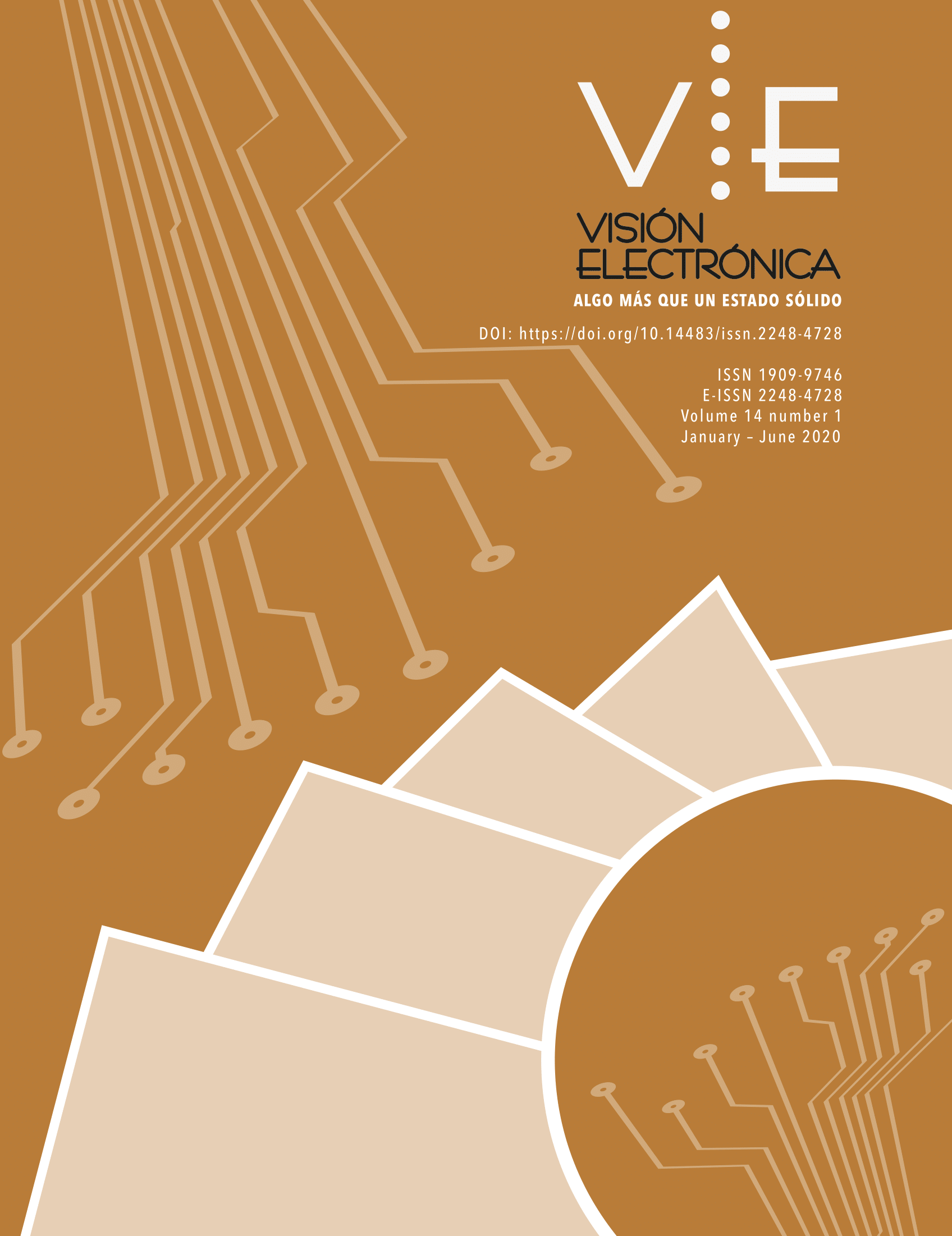DOI:
https://doi.org/10.14483/22484728.16351Publicado:
2020-01-31Número:
Vol. 14 Núm. 1 (2020)Sección:
Visión InvestigadoraPrimary user emulation characterization in mobile cognitive radio networks
Caracterización de emulación de usuario primario en redes móviles de radio cognitiva
Palabras clave:
Mobile cognitive radio network, Primary user emulation, Security, Software defined radio, USRP (en).Palabras clave:
Redes móviles de radio cognitiva, Emulación de usuario primario, Seguridad, Radio definido por software, USRP (es).Descargas
Resumen (en)
This paper presents the results of the characterization of the attack known as the "primary user emulation" in mobile cognitive radio networks performing the implementation and testing. The tools and their configuration to carry out the attack are presented and their effects on the network are analyzed. The results show how to generate the attack with a software-defined radio equipment (SDR) using GNU-Radio and OpenBTS. The effects of the possible configurations of the attack on the network are shown, the malicious type generates constant interference on the primary or cognitive network, the selfish type allows to imitate a licensed or primary user generating interference to the primary network and inability to access the Cognitive Network while active. If the emulator's power level is fixed, the services it provides are stable. If the power is variable the services suffer intermittency. Primary user emulation is the attack that most affects the cognitive radio network so its effects are analyzed in order to propose ways of detecting or applying countermeasures.
Resumen (es)
En este artículo se presentan los resultados de la caracterización del ataque conocido como la “emulación de usuario primario” en redes móviles de radio cognitiva realizando la implementación y pruebas. Se presentan las herramientas y su configuración para efectuar el ataque y se analizan sus efectos sobre la red. Los resultados muestran cómo generar el ataque con un equipo de radio definido por software (SDR) utilizando GNU-Radio y OpenBTS. Se muestran los efectos de las posibles configuraciones del ataque sobre la red, el tipo malicioso genera interferencia constante sobre la red primaria o cognitiva, el tipo egoísta permite imitar un usuario licenciado o primario generando interferencia a la red primaria e imposibilidad de acceso a la red cognitiva mientras este activo. Si el nivel de potencia del emulador es fijo los servicios que presta son estables. Si la potencia es variable los servicios sufren intermitencia. La emulación de usuario primario es el ataque que más afecta la red de radio cognitiva por lo que se analizan sus efectos para poder plantear formas de detección o aplicar contramedidas.
Referencias
L. F. Pedraza, F. Forero, and I. P. Paez, “Evaluación de ocupación del espectro radioeléctrico en Bogotá-Colombia”, Ing. Cienc., vol. 10, no. 19, pp. 127–143, 2014. https://doi.org/10.17230/ingciencia.10.19.6
M. Karimi and S. M. S. Sadough, “Efficient Transmission Strategy for Cognitive Radio Systems Under Primary User Emulation Attack”, IEEE Syst. J., 2017. https://doi.org/10.1109/JSYST.2017.2747594
G. Baldini, T. Sturman, A. R. Biswas, R. Leschhorn, G. Godor, and M. Street, “Security aspects in software defined radio and cognitive radio networks: A survey and a way ahead”, IEEE Commun. Surv. Tutor., vol. 14, no. 2, pp. 355–379, 2012. https://doi.org/10.1109/SURV.2011.032511.00097
S. Rizvi, J. Mitchell, and N. Showan, “Analysis of security vulnerabilities and threat assessment in Cognitive Radio (CR) networks”, in IEEE 8th International Conference on Application of Information and Communication Technologies (AICT), 2014. https://doi.org/10.1109/ICAICT.2014.7035911
K. K. Chauhan and A. K. S. Sanger, “Survey of Security threats and attacks in cognitive radio networks”, in International Conference on Electronics and Communication Systems (ICECS), 2014. https://doi.org/10.1109/ECS.2014.6892537
L. Jianwu, F. Zebing, F. Zhiyong, and Z. Ping, “A survey of security issues in cognitive radio networks”, China Commun., vol. 12, no. 3, pp. 132–150, 2015. https://doi.org/10.1109/CC.2015.7084371
M. Ghaznavi and A. Jamshidi, “Defence against Primary User Emulation Attack Using Statistical Properties of the Cognitive Radio Received Power”, IET Commun., vol. 11, no. 9, 2017. https://doi.org/10.1049/iet-com.2016.1248
J. Avila, S. Prem, S. Rajapradeepa, and K. Thenmozhi, “Authentication Based Primary User Emulation Attack Mitigation in Cognitive Radio”, in International Conference on Computer Communication and Informatics (ICCCI), 2018. https://doi.org/10.1109/ICCCI.2018.8441397
W. F. Fihri, H. El Ghazi, N. Kaabouch, and B. A. El Majd, “Bayesian decision model with trilateration for primary user emulation attack localization in cognitive radio networks”, in International Symposium on Networks, Computers and Communications (ISNCC), 2017. https://doi.org/10.1109/ISNCC.2017.8071979
Y. Li, C. Han, M. Wang, H. Chen, and L. Xie, “A primary user emulation attack detection scheme in cognitive radio network with mobile secondary user”, in 2nd IEEE International Conference on Computer and Communications (ICCC), 2016. https://doi.org/10.1109/CompComm.2016.7924870
C. A. H. Suárez, L. F. P. Martínez, and F. H. M. Sarmiento, “Algoritmos para asignación de espectro en redes de radio cognitiva”, Tecnura, vol. 20, no. 48, pp. 69–88, 2016. https://doi.org/10.14483/udistrital.jour.tecnura.2016.2.a05
C. R. Stevenson, G. Chouinard, Z. Lei, W. Hu, S. J. Shellhammer, and W. Caldwell, “IEEE 802.22: The first cognitive radio wireless regional area network standard”, IEEE Commun. Mag., vol. 47, no. 1, pp. 130–138, 2009. https://doi.org/10.1109/MCOM.2009.4752688
S. M. Elghamrawy, “Security in cognitive radio network: defense against primary user emulation attacks using genetic artificial bee colony (GABC) algorithm”, Future Gener. Comput. Syst., 2018. https://doi.org/10.1016/j.future.2018.08.022
S. Shrivastava, A. Rajesh, and P. Bora, “Defense against primary user emulation attacks from the secondary user throughput perspective,” AEU-Int. J. Electron. Commun., vol. 84, pp. 131–143, 2018. https://doi.org/10.1016/j.aeue.2017.11.012
M. Iedema, “Getting Started with OpenBTS: Build Open Source Mobile Networks”, O’Reilly Media, Inc., 2014.
F. Jin, V. Varadharajan, and U. Tupakula, “Improved detection of primary user emulation attacks in cognitive radio networks”, in International Telecommunication Networks and Applications Conference (ITNAC), 2015. https://doi.org/10.1109/ATNAC.2015.7366825
J. C. Briñez de León, H. A. Fandiño Toro, A. Restrepo Martínez, y J. W. Branch Bedoya, “Análisis de resolución en imágenes de fotoelasticidad: caso carga dinámica”, Visión electrónica, vol. 11, no. 1, pp. 69-75, jun. 2017. https://doi.org/10.14483/22484728.12789
Cómo citar
APA
ACM
ACS
ABNT
Chicago
Harvard
IEEE
MLA
Turabian
Vancouver
Descargar cita
Licencia

Esta obra está bajo una licencia internacional Creative Commons Atribución-NoComercial 4.0.
.png)
atribución- no comercial 4.0 International






.jpg)





